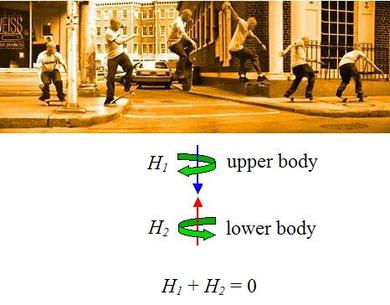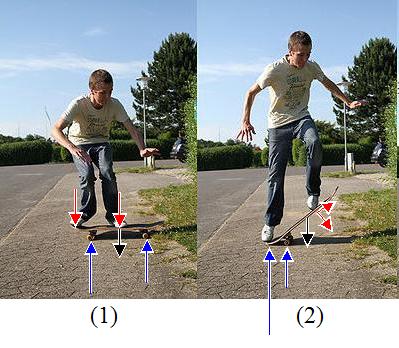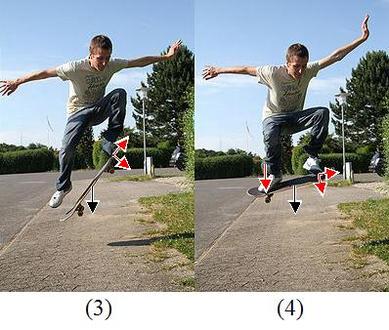 Source: Mid-Air Maneuvers © The Exploratorium, www.exploratorium.edu
Source: Mid-Air Maneuvers © The Exploratorium, www.exploratorium.edu
Mid-air manuvers:
The Physics of a Frontside-180:
The Frontside-180 is a skateboarding trick in which the skater will rotate their skateboard in mid-air 180 degrees so when they land they are skating on the opposite side of their body. The Frontside 180 involves angular momentum. In the air, the only force working on the skater is gravity. Gravity can't exert torque, but it acts on the skateboard and the skateboarder (the system). To rotate the board 180 degrees, the skater rotates their upper and lower body in the opposite directions so the net angular momentum will be equal to zero. This is illustrated in the equation written below that angular momentum is conserved during this trick. H_1 is equal to the angular momentum of the skater's upper body and H_2 is equal to the angular momentum of their lower body. For the skater to get their H_1 value equal and oppsite of H_2, they must put their arms up while in mid-air which will increase their rotational inertia and angular velocity of the body. When the skateboarder lands, they land with their body back in the same direction as their lower body this is due to applying torque to the ground.
The Physics of an Ollie:
The ollie is the basis of doing tricks on a skateboard. In this trick, you do a jump on your board to clear an obstacle. If you've ever observed a skater doing an ollie, it looks like they are catching a couple feet of air as if their skateboard is attached to their feet as if it's a snowboard. But, in reality the boarder uses their weight on the board to keep it under their feet.
There are three forces acting on a skateboarder while they are skating right before their big trick: their weight, gravity, and the normal force on the skateboard. These net forces add up to zero which keeps the skater accelerating at a constant speed. As the skater prepares to do an ollie, they lower their body to get a lessen their center of mass which in turn would give them a higher jump. The skater then keeps his legs straightened and raises their arms while putting weight on their rear wheels and less weight on the front wheels to pivot the rear. This gives a large force on the back wheel causing the front to jump up and allowing the board to turn in the clockwise position around the skater's center of mass. After, they move their front foot on the board while in mid-air to gain a higher flight.The feet of the skater allow them to apply torque, which is a twisting force that causes rotation, to their skateboard while in mid-air, this gives the skater control of their board. Then, the boarder moves that front foot back in attempt to level out the board, and then moving both feet simultaneously towards the rear of the board. At maximum height, the boarder then puts both feet on their skateboard and prepares to land back on solid ground due to gravity but remembering to bend their knees to soften their landing.
The Physics of a Frontside-180:
The Frontside-180 is a skateboarding trick in which the skater will rotate their skateboard in mid-air 180 degrees so when they land they are skating on the opposite side of their body. The Frontside 180 involves angular momentum. In the air, the only force working on the skater is gravity. Gravity can't exert torque, but it acts on the skateboard and the skateboarder (the system). To rotate the board 180 degrees, the skater rotates their upper and lower body in the opposite directions so the net angular momentum will be equal to zero. This is illustrated in the equation written below that angular momentum is conserved during this trick. H_1 is equal to the angular momentum of the skater's upper body and H_2 is equal to the angular momentum of their lower body. For the skater to get their H_1 value equal and oppsite of H_2, they must put their arms up while in mid-air which will increase their rotational inertia and angular velocity of the body. When the skateboarder lands, they land with their body back in the same direction as their lower body this is due to applying torque to the ground.
The Physics of an Ollie:
The ollie is the basis of doing tricks on a skateboard. In this trick, you do a jump on your board to clear an obstacle. If you've ever observed a skater doing an ollie, it looks like they are catching a couple feet of air as if their skateboard is attached to their feet as if it's a snowboard. But, in reality the boarder uses their weight on the board to keep it under their feet.
There are three forces acting on a skateboarder while they are skating right before their big trick: their weight, gravity, and the normal force on the skateboard. These net forces add up to zero which keeps the skater accelerating at a constant speed. As the skater prepares to do an ollie, they lower their body to get a lessen their center of mass which in turn would give them a higher jump. The skater then keeps his legs straightened and raises their arms while putting weight on their rear wheels and less weight on the front wheels to pivot the rear. This gives a large force on the back wheel causing the front to jump up and allowing the board to turn in the clockwise position around the skater's center of mass. After, they move their front foot on the board while in mid-air to gain a higher flight.The feet of the skater allow them to apply torque, which is a twisting force that causes rotation, to their skateboard while in mid-air, this gives the skater control of their board. Then, the boarder moves that front foot back in attempt to level out the board, and then moving both feet simultaneously towards the rear of the board. At maximum height, the boarder then puts both feet on their skateboard and prepares to land back on solid ground due to gravity but remembering to bend their knees to soften their landing.

